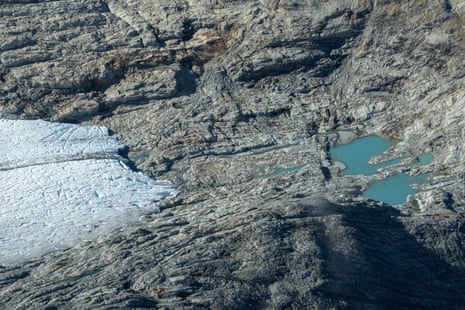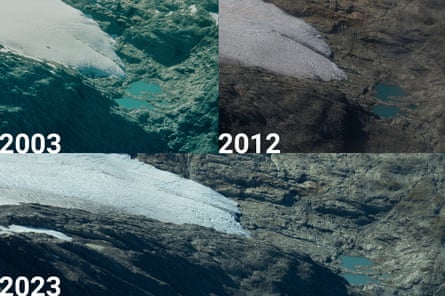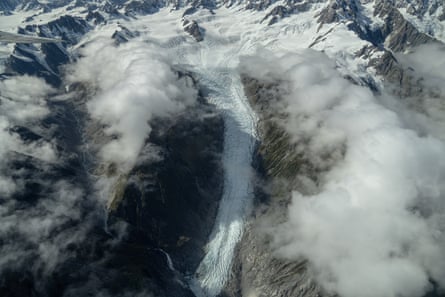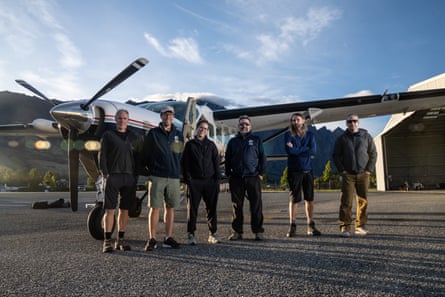‘It slips through our fingers’: New Zealand scientists are distraught at the scale of glacier loss.new zealand
The plane’s engine roars, and a small aircraft rises. Through a thin film of clouds, the spine of the Southern Alps rises like a dark saw blade.
“I wonder if my favorite glacier is there,” says lead climate scientist Dr. Andrew Lowry. “It’s been a really, really hot summer this year. Hard to say. We’ll have to see how they did.”
On Sunday morning, in the pre-sunrise darkness, a small group of six scientists gathered on the asphalt of Queenstown’s small airfield, cameras stuffed into backpacks and a wash of color leaking over the mountains. . For most of his next eight hours, they sat twisted in their chairs, their spines cramped, their lenses aligned with the windows to capture the peaks of the Southern Alps emerging from the cloud cover. This is New Zealand’s annual snowline survey, an annual charter flight by Climate Research Institute Niwa that attempts to capture the state of the country’s glaciers before winter sets in. Prepare for the worst.
As the tiny plane circles the peak, the pilot flicks between different maps on the tablet while comparing notes with the scientific team via headset to track the exact location of the cloud-covered glacier. will do.
Out the far window, the blue-grey expanse of Brewster Glacier looms to the right. Large glaciers such as Fox and Franz his Joseph are shrinking, but they are still huge, like thick ribbons of pale blue crepe wrinkled, cracked, and crumpled by the pressure of the downhill flow. faces you as an icy river. Elsewhere, however, dark dikes are emerging, eroding deeper and deeper into the glacier’s pale core. Brewster’s ice layer looks like slices of quartz undulating with thin ribs of black debris and apricot sediments. It has been replaced by the dark sheen of exposed rock.
“It’s really dramatic,” said Professor Andrew McIntosh, the exhibition’s lead scientist, as he looks back at the headrests to scream the roar of the engine. “I never imagined I would see such a change in my life. It is very serious.”

A glaciologist now based at Monash University in Australia, McIntosh helped start a monitoring program at New Zealand’s Brewster Glacier in 2004. “It’s been 20 years and how…” he stutters. “It will take a while to disappear completely, but it no longer has the characteristics of a happy, living glacier. It looks like something that is crumbling and no longer with us.”
Scenery facing each other
It’s sad to see the ice melt. Some of these scientists have been monitoring these glaciers for decades, returning each year to photograph them. They know each name and have personal favorites. Some of the glaciers they documented have disappeared in the last decade. Mackintosh and Laurie occasionally exchange ideas while leaning against a gray vinyl seat and looking out a shivering window. “She looks like shit,” says one of them.
“It’s interesting as a scientist to see that change, but as a human being it’s a little more challenging,” McIntosh says. “There’s a kind of conflict between the fascination with how quickly the system is changing and the emotional reaction to seeing ice, a very important part of the landscape, a very beautiful and culturally significant part, lost. .”

“The scale of the recession has even faced glaciologists.”
During the winter, snow covers the glaciers and slopes with thick, smooth slabs of marzipan. Its snow nourishes and protects the glacier, increasing the amount of ice before the warm months strip it away. and form tars that feed the braided rivers below. I’m here. “This is a melting glacier, top, bottom, sides, it’s just melting,” McIntosh says.
As the seasonal climate warms in the spring and summer, the snow line peels off. As the plane orbits behind his Mount Bryant, Raleigh points to where the snow has been pulled back from the ice. “Can you see the ice here? All the bluish ice is bare and stripped away. … So he of the whole glacier is 80%, 90% melted. is,” he says.
he shakes his head a little. “It is emaciated.”
aAs the plane lands at the airfield on Lake Tekapo, Laurie points out folds and drainage channels in the plains. “18,000 years ago, this entire valley was filled with ice,” he says. But if ice movement had been measured over hundreds or thousands of years, it is now moving much faster and is set back from years or decades of warming. It was the hottest year on record. The record was broken two years in a row.

The flight will attempt to record more than 50 glacier snowlines, some of which have been monitored in this way for the past 46 years. But over time, some of the Index Glaciers disappeared and were replaced by their higher-range cousins. Niwa predicts that many of New Zealand’s important glaciers will be gone within a decade..
There is still hope for the remaining glaciers, Lowry says. A fraction of the warming is the difference between New Zealand’s glaciers joining together or disappearing altogether.
“We need rapid change. We need rapid action to change the course we are on,” says Lowry. Damage can be repaired quickly, but repair takes much longer. “These sudden and absolutely rapid [losses] “But it’s a glacially slow process to replenish that ice and restore it to its full glory.”


“We know what is driving glacier loss,” says Lowry. “We know that there A close relationship between changes in temperature and changes seen in glaciers…we know that path is highly dependent on CO2 emissions. “
“It’s a bit of an inspiration to see the amazing and pristine parts of our natural environment slip through our fingers. I don’t know if you’ll get … it’s fast.
“We have to tackle this problem more directly and more quickly.”
After all, Raleigh’s favorite Lorennie Peaks was not able to record this year. He was shrouded in thick clouds and could not be seen through the plane’s windows.
“In a way, I’m happy,” he says. “Because I think he would have been crying without it.
https://www.theguardian.com/world/2023/apr/01/slipping-through-our-fingers-new-zealand-scientists-distraught-at-scale-of-glacier-loss ‘It slips through our fingers’: New Zealand scientists are distraught at the scale of glacier loss.new zealand
